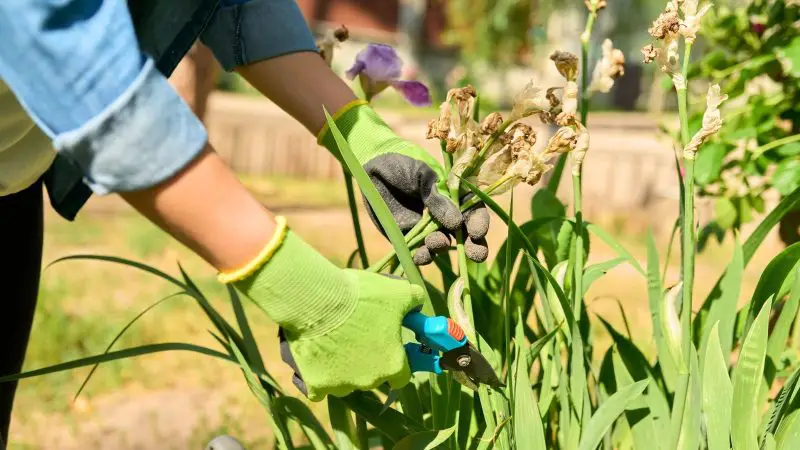Irises are among the most cherished flowering plants in gardens worldwide. Known for their elegant blooms and striking foliage, they bring vibrant colors and refined textures to landscapes. However, like many perennials, irises require proper care to thrive year after year. One essential aspect of iris maintenance is pruning, which involves cutting down the plant at specific times to promote health, encourage blooming, and prevent disease. A common question many gardeners ask is: When do you cut down irises?
This guide dives deeply into the best timing and techniques for cutting down irises, helping you achieve perfect pruning results every season.
Understanding Iris Growth and Its Lifecycle

To prune irises effectively, it is important first to understand their growth cycle and general characteristics. Irises belong to a diverse genus with hundreds of species, but many gardeners grow bearded irises, Siberian irises, or Japanese irises. These perennials grow from rhizomes or bulbs and typically feature tall, sword-shaped leaves and stunning flowers that bloom in spring or early summer.
During their growing season, irises produce flower stalks that carry multiple blooms. After flowering, the plant begins to shift its energy away from blooms toward storing nutrients in its rhizomes to survive the dormant season. The leaves remain green for a while after the flowers fade, continuing photosynthesis and supporting the rhizomes’ development.
Knowing this growth pattern is crucial for timing your pruning correctly, ensuring the plant stays healthy and blooms well the next year.
Why Is Cutting Down Irises Important?
Cutting down irises is a vital gardening task with several benefits. Firstly, removing spent flower stalks and trimming back foliage prevents the plant from wasting energy on seed production and dying leaves. This energy conservation directs nutrients back into the rhizomes, helping strengthen the plant.
Secondly, cutting down old or dead foliage reduces the risk of diseases and pests, which often thrive in decaying plant matter. Irises can be susceptible to fungal infections such as leaf spot or rhizome rot if not properly maintained.
Finally, pruning helps maintain the plant’s shape and appearance. Irises can become untidy with brown, dead leaves or excessive leaf growth, which can overshadow other plants and make the garden look less appealing.
When Do You Cut Down Irises for Best Results?
The timing of when you cut down irises depends largely on your local climate and the type of iris you grow, but there are general guidelines to follow. Typically, the best time to prune irises is after they finish blooming and the foliage begins to yellow or die back naturally.
In most temperate climates, this means pruning in late summer or early fall, usually between August and September. At this point, the irises have completed their flowering cycle, and the leaves have done most of their photosynthesis work for the year. Cutting back now prepares the plant for dormancy and reduces the chance of disease during winter.
In warmer climates, pruning might occur a little later, while in colder regions, gardeners might prune a bit earlier before the first frost. Observing the plant’s condition is the best indicator: prune when leaves start turning yellow or brown but before they become entirely dead.
How to Prepare for Cutting Down Irises
Before starting to cut down irises, prepare your tools and area properly to ensure clean cuts and prevent spreading diseases. Use sharp, sterilized garden scissors or pruning shears to avoid crushing the leaves and stems. Sterilizing your tools with rubbing alcohol or a bleach solution between plants reduces the risk of infection.
Inspect the iris clumps for any signs of disease or pests, such as unusual spots, mold, or insect damage. Removing unhealthy foliage immediately during pruning helps keep the overall bed healthy.
Clearing the ground around the irises of fallen leaves, debris, or weeds is also beneficial. This minimizes hiding spots for pests and keeps the garden tidy.
Step-by-Step Guide to Cutting Down Irises
Start pruning by cutting off the flower stalks at the base once the blooms fade. This step removes spent flowers and prevents seed formation, allowing the plant to focus energy on root development.
Next, trim the foliage back to about 4 to 6 inches above the ground or rhizome. It is important not to cut the leaves too short, as some green foliage is necessary for photosynthesis and nutrient storage.
For leaves that are yellowed, brown, or damaged, remove them completely. Healthy green leaves can be left to continue supporting the plant through the end of the growing season.
If you notice any thick or crowded rhizomes, late summer or fall is a good time to divide the iris clumps. Dividing helps rejuvenate the plants and promotes better blooming the following year.
Common Mistakes When Cutting Down Irises
One of the most common mistakes gardeners make is pruning irises too early. Cutting leaves while they are still green and photosynthetically active deprives the plant of energy, which can weaken rhizomes and reduce next season’s blooms.
Another frequent error is leaving too much dead or diseased foliage on the plant, which increases the risk of fungal diseases. Dead leaves can harbor spores that spread throughout the garden.
Over-pruning or cutting leaves too close to the ground is also problematic. The plant needs some leaf area to gather sunlight and store energy, so leaving a few inches of healthy foliage is crucial.
Finally, neglecting to clean and sterilize tools between plants can inadvertently spread infections, causing problems in previously healthy irises.
Caring for Irises After Cutting Down
After pruning, irises benefit from some attentive care. Watering moderately encourages the rhizomes to store nutrients but avoid overwatering, which can cause root rot. Applying a balanced fertilizer in early spring supports healthy new growth and blooming.
Mulching around the plants with organic matter or gravel helps retain moisture, control weeds, and protect the rhizomes from extreme temperatures. However, avoid heavy mulch directly on the rhizomes, as this can promote rot.
Regular monitoring for pests like iris borers and fungal diseases is essential, especially after pruning when plants are vulnerable. Early treatment ensures robust health.
How Cutting Down Irises Influences Blooming
Proper pruning positively affects blooming by allowing irises to concentrate energy on producing healthy flower stalks the following year. By cutting off spent flowers and trimming the leaves at the right time, the plant avoids wasting resources on seed production or decaying tissues.
Failing to prune correctly can lead to reduced flower size, fewer blooms, or delayed flowering. Overgrown foliage may also shade flowers or crowd neighboring plants, diminishing overall garden aesthetics.
Consistent, well-timed cutting down ensures vibrant, prolific iris blooms that brighten any garden.
Differences in Pruning Based on Iris Varieties
While the general pruning principles apply broadly, different iris varieties may require slight adjustments. Bearded irises, for example, benefit from cutting the foliage back in late summer once it yellows, while Siberian irises tend to hold their leaves longer and may be pruned closer to fall or early winter.
Japanese irises prefer minimal pruning and can tolerate more leaf growth throughout the season. Knowing your iris type helps tailor pruning for best results.
Seasonal Considerations and Regional Variations
Regional climate significantly influences the timing of iris pruning. In mild, Mediterranean climates, pruning can be delayed until late fall or early winter. Conversely, in colder zones with harsh winters, pruning is better done earlier in late summer to allow the plant time to harden off before frost.
Gardeners in regions with wet winters must be especially diligent about removing dead foliage to prevent rot. Meanwhile, those in dry areas should ensure irrigation supports iris recovery after pruning.
Signs That Indicate It’s Time to Cut Down Irises
Observing your irises closely reveals when they are ready for cutting down. Leaves that begin turning yellow or brown, flower stalks that have finished blooming, or overall plant decline indicate it’s time to prune.
If the foliage looks ragged, diseased, or excessively long and untidy, pruning helps restore the plant’s health and appearance. Waiting too long may increase disease risk or stress the plant over winter.
FAQ about When Do You Cut Down Irises
When is the best time to cut down irises?
The best time to cut down irises is after they finish blooming and the foliage begins to yellow, usually in late summer or early fall.
Why should you cut down irises after flowering?
Cutting down irises after flowering helps the plant conserve energy by preventing seed production and promotes healthy rhizome development.
Can you cut down irises too early?
Yes, pruning irises too early, while leaves are still green, can weaken the plant and reduce blooms in the next season.
How much should you cut back iris foliage?
It’s best to trim foliage to about 4 to 6 inches above the ground, leaving enough leaf area for photosynthesis.
Should you remove dead or diseased leaves when cutting down irises?
Yes, removing dead or diseased leaves reduces the risk of fungal infections and helps maintain overall plant health.
Final Thoughts: Achieving Perfect Iris Pruning
Cutting down irises at the right time with proper technique is essential for maintaining healthy, beautiful plants that bloom reliably year after year. By understanding the plant’s growth cycle, observing seasonal cues, and carefully pruning foliage and spent flowers, gardeners can enjoy stunning iris displays in their gardens.
Avoiding common mistakes like premature pruning, overcutting, or neglecting tool sanitation further supports plant vigor. Coupled with attentive aftercare, including watering and fertilizing, iris pruning becomes a rewarding task that enhances garden beauty and plant longevity.
Whether you grow bearded, Siberian, or Japanese irises, this guide to perfect pruning will help you make informed decisions about when do you cut down irises, ensuring your plants remain a highlight of your landscape season after season.






